Exploring Taipei’s vibrant indoor markets: A flavorful journey through history and culture

Source:Taiwan Scene
Taipei's vibrant indoor markets are a testament to the city's rich tapestry of history and culture, offering an immersive journey for visitors keen to explore the essence of local life. Join us on a flavorful journey through Taipei's indoor markets, where every stall and alleyway tells a story of Taipei's vibrant heart and soul.
Views
Exploring Taipei’s vibrant indoor markets: A flavorful journey through history and culture
By Jonathan Kaplanweb only
Markets symbolize the evolution of local culture and serve as microcosms of a city’s essence. These markets are integral to local life, preserving tradition and community spirit.
Traditional markets are an indispensable facet of Taiwan’s everyday life, featuring a variety of fresh vegetables, live poultry, and seafood, alongside eateries, grocery stores, and clothing boutiques. Distinguished by their operating hours, morning markets cater to the early hours, while evening markets come alive during the late afternoon and after work. Typically, people buy poultry and seafood at the morning markets and pork, fruits, and vegetables at the evening markets.
Pick a point in the city, pay attention long enough, and you too will observe the particular daily rhythms of that place. A good place to start would be at one of Taipei’s traditional covered markets.
In the densely-populated capital city, these indoor markets are typically open and active from around 7 am to 7 pm. Here the city’s rhythms are amplified amid the tightly-bunched grocery stalls, the farmers’ stands, the upstairs eateries, and the clothing and accessory shops where artisans hand-make their goods while you peruse the stalls of cultural curios and fine goods out on display for both aficionados and casual shoppers to admire.
For visitor seeking an immersive, down-to-earth experience of Taiwan’s local culture, here are a few unique markets to explore.
Nanmen market: A modern update of a neighborhood market
Just outside MRT Chiang Kai-Shek Memorial Hall Station is a gleaming new building that would fit right into any modern downtown, but upholds an honored tradition as the home of the area’s century-old Nanmen Market (南門市場).
Established during the Japanese era in 1907, it has been the neighborhood’s go-to spot for fresh and prepared foods, snacks, hot meals, tea, ingredients, and a variety of specialty goods for nearly 120 years.
Nanmen Market’s original building underwent a city-initiated renovation in 2016 to enhance safety and convenience for visitors and vendors alike.
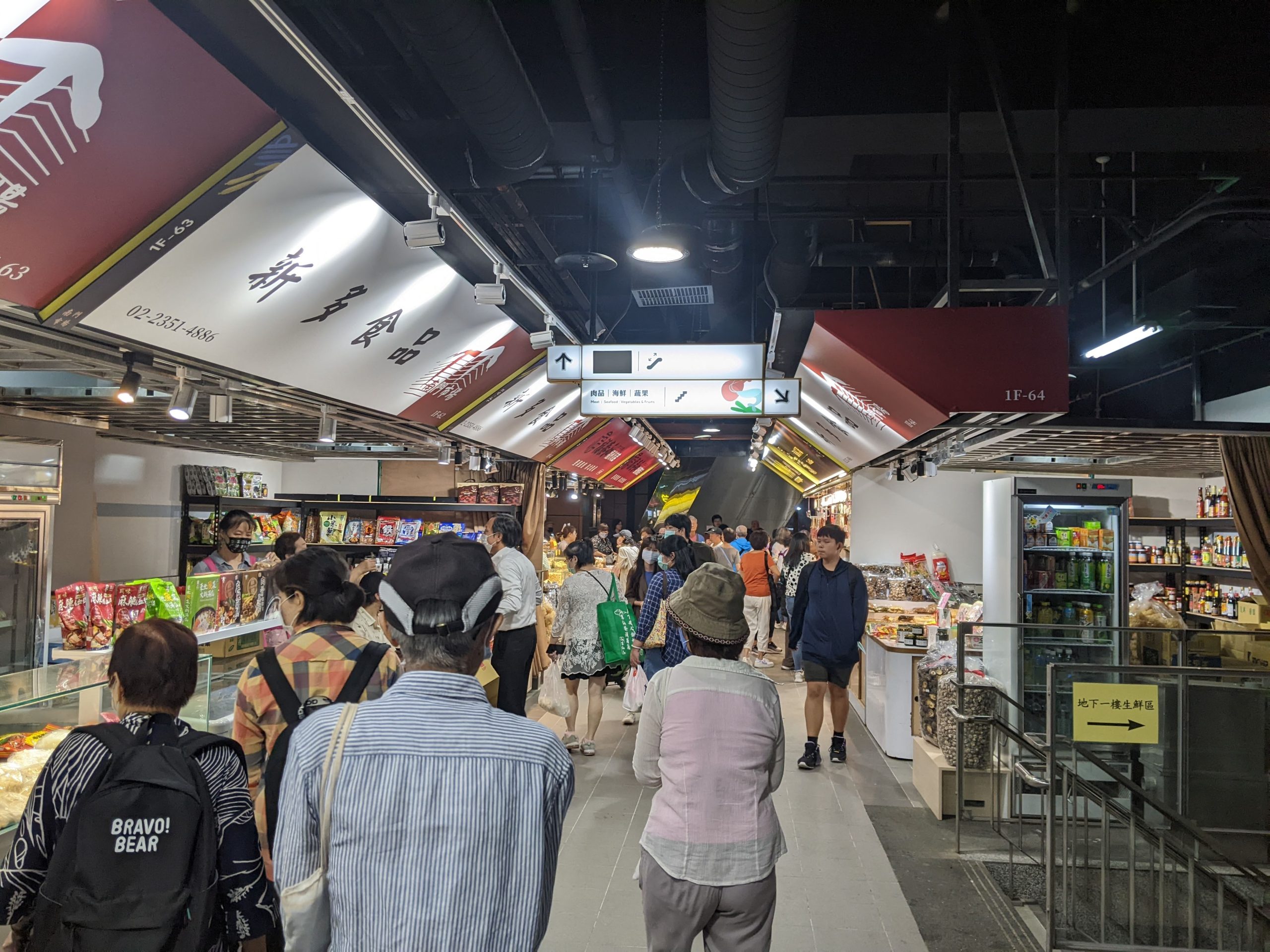 The first floor of Nanmen Market features typical food stalls selling fresh and cooked food, as well as dried food. (Source: Jonathan Kaplan)
The first floor of Nanmen Market features typical food stalls selling fresh and cooked food, as well as dried food. (Source: Jonathan Kaplan)
During a transitional phase, vendors were first moved to a nearby interim market in 2019. The ensuing pandemic led to daunting challenges, but in 2023, Nanmen Market finally reopened in its original location, with a grand reopening in October.
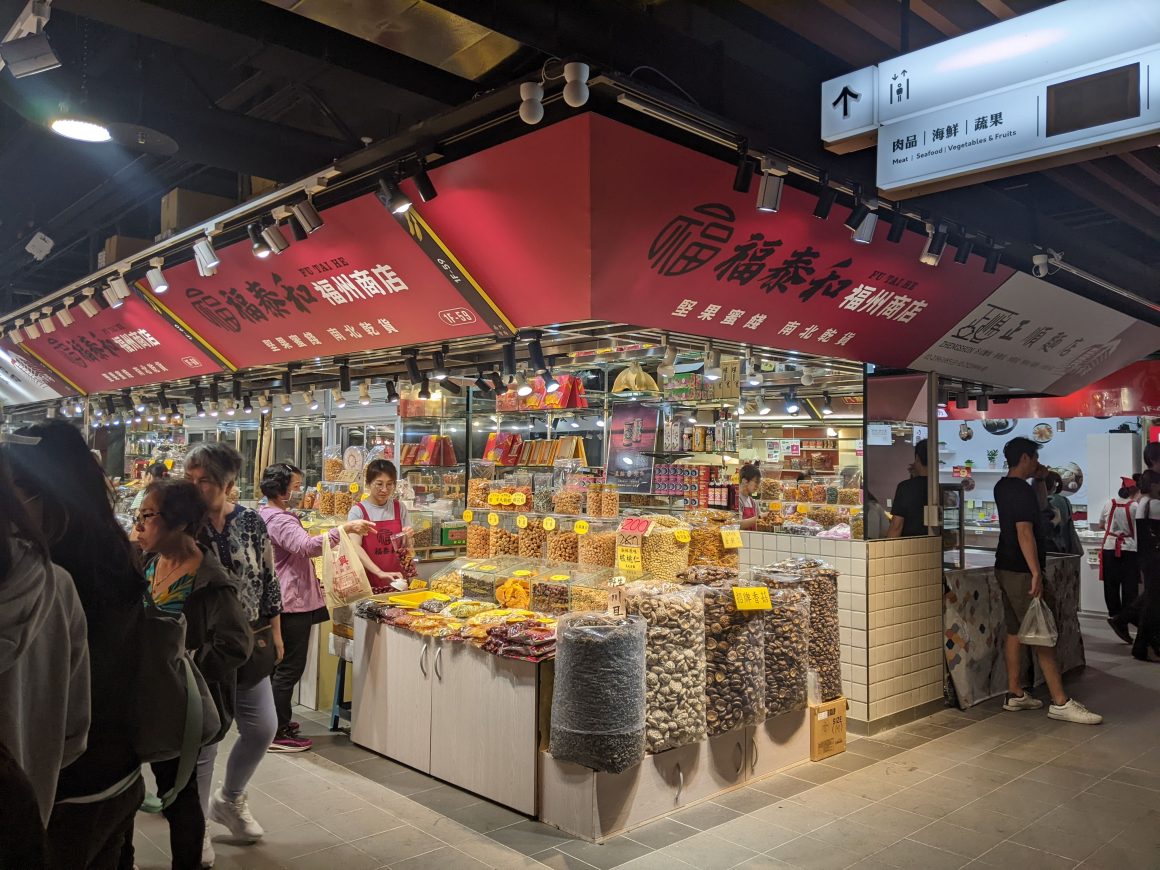 Dried fruits, nuts, and mushrooms fill the air with their delicate fragrance. (Source: Jonathan Kaplan)
Dried fruits, nuts, and mushrooms fill the air with their delicate fragrance. (Source: Jonathan Kaplan)
The first floor, with over a hundred independent stalls, is dedicated entirely to food. Indeed, it is a paradise for intrepid gourmands. One section features stalls selling dry goods: dried and candied fruit of every stripe (the guava is a must-try), nuts, grains, giant bags of dried mushrooms, and even dried scallops and cured pork belly are on offer here. Turn the corner and hot prepared foods are selling fast for local residents to take home for an indulgent feast. Under a long magenta sign, Yi-Chang Yufang (億長御坊) doles out dishes like peeled shrimp with peas, sanbeiji (three-cup chicken), braised goose wings, stewed bamboo shoots, and many more. Other must-visit shops include Hoshin (合興糕糰), with its well-known Shanghai-styled steamed sponge cake, King Long Jerky’s (金龍肉乾) sweetened and spiced pork jerky and Nan-Yuan’s (南園) zongzi (sticky rice dumplings wrapped in bamboo leaves) to name a few.
Asked what changes she sees in the new market building compared to the old, a shopkeeper who has been in business for 40 years recalled, “The old market was very traditional. There was no air conditioning, and it was very narrow.” The new Nanmen Market is a major upgrade — climate controlled and comfortable to move around in.
On the second floor, shops sell everything from jackets and jeans to fine wooden combs and jade jewelry. One shop in particular, Tianfu (天福), prominently displays delicate ceramic tea cups with beautiful designs. Ms. Wang, the shopkeeper, is eager to explain that much of the finery she sells is Kutani ware from Kaga, Japan, a type of porcelain dating back to Japan’s Edo period.
Poke around the upstairs shops of Nanmen Market and you will inevitably find some irresistible treasures. One such treasure is in the second floor’s food court area: the inimitable Hehuan Knife Cut Noodle Restaurant (合歡刀削麵). The menu features English translations for all eight options, and it is impossible to choose wrong here. The tomato beef noodle soup is so delicately rich and flavorful, with such tender beef. No wonder it’s a local favorite, and you might just find yourself coming back for more.
The market’s incredible array of sights, fragrances, flavors, and finery are a marvelous introduction to the essence of Taiwan’s traditional marketplace, where local and niche imported regional products find their rightful place in customers’ hands (and bellies).
Shi-Dong market: A gourmet’s dream hidden in the north
Taipei’s Tianmu (天母) neighborhood is an enclave at the base of Yangmingshan Mountain, tucked away from the hustle and bustle of downtown. Hidden here is a delightful indoor market stands ready to feed visitors’ curiosity and appetites: Shi-Dong Market (士東市場).
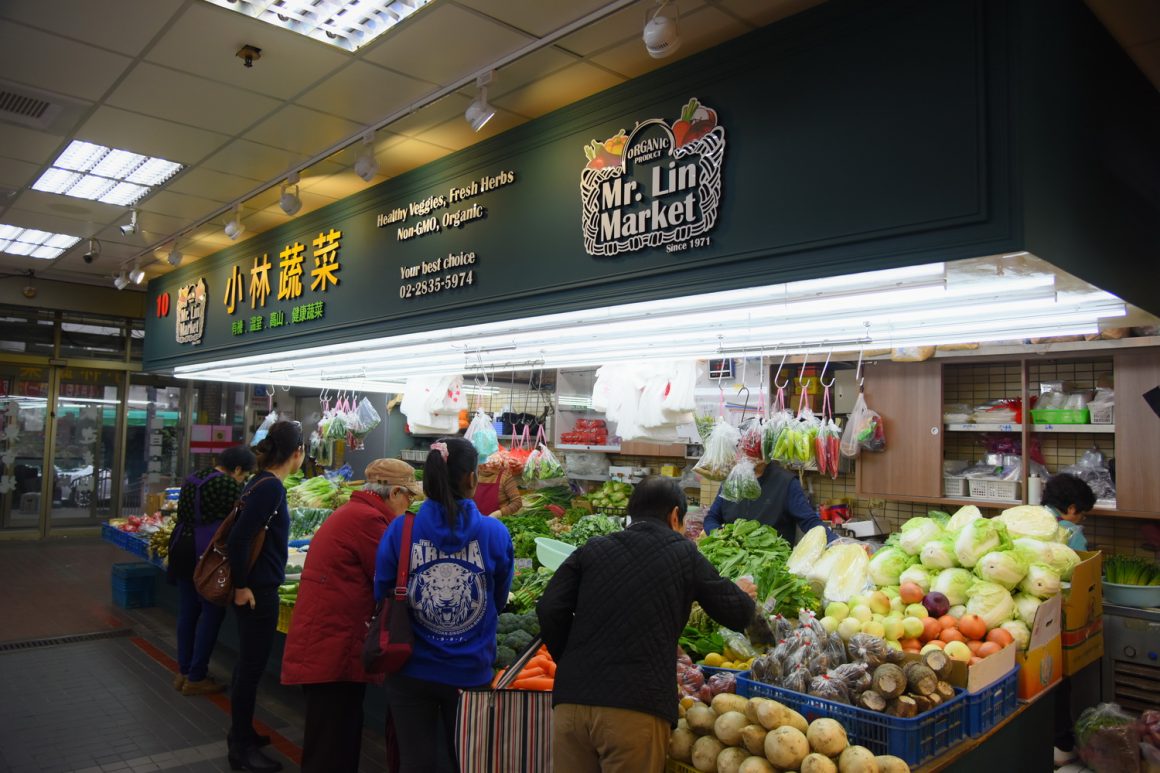 The display of fresh groceries at Shi-Dong Market is the preferred choice for nearby residents’ produce needs. (Source: Shi-Dong Market)
The display of fresh groceries at Shi-Dong Market is the preferred choice for nearby residents’ produce needs. (Source: Shi-Dong Market)
A relatively new indoor market, Shi-Dong first opened its doors in 1992 to much local fanfare. Clean, bright, and well laid-out, it quickly became a neighborhood institution. As with Nanmen Market, the first floor is primarily dedicated to fresh produce and specialty groceries, while the second floor is divided between a central shopping gallery for clothes, antiques, handmade purses, and jewelry, with long halls of restaurant stalls on either side. Those restaurants are a major draw of the market, with everything from micro cafes to Korean food stalls, shaved ice desserts, and classic Taiwanese eateries getting a steady flow of satisfied diners throughout the day.
Back on the first floor, there is a standing sashimi restaurant, A-ji-shi (阿吉師), with delectably fresh fish, nestled among a hundred or so fresh grocers and specialty produce stores. Many of the stalls in Shi-Dong Market migrated there from the surrounding neighborhood when the building opened in 1992, including Mr. Lin Market (小林蔬菜), an organic vegetable stall, originally established in 1971.
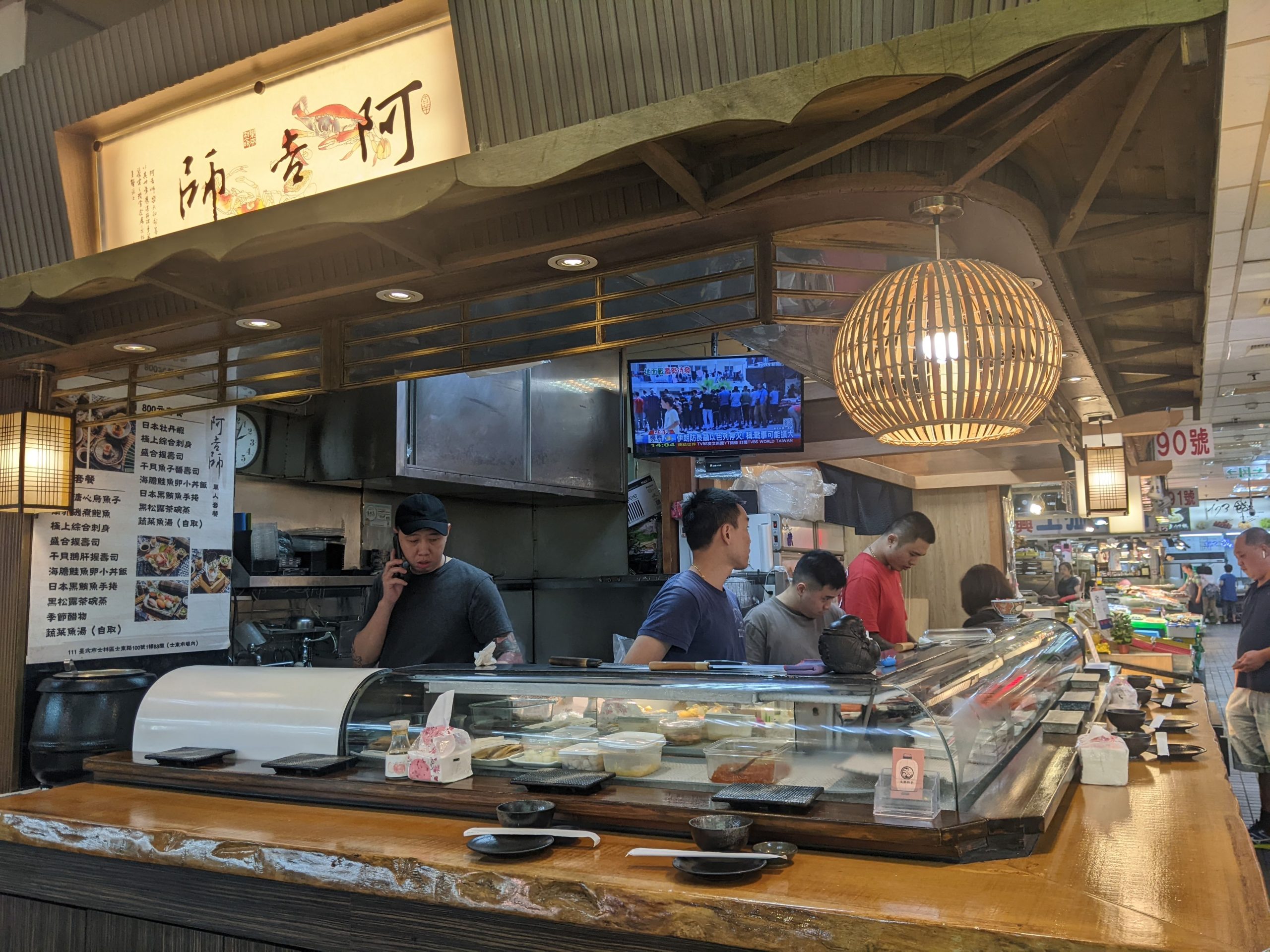 A-ji-shi stand-up sashimi restaurant at Shi-Dong Market offers a unique dining experience. (Source: Jonathan Kaplan)
A-ji-shi stand-up sashimi restaurant at Shi-Dong Market offers a unique dining experience. (Source: Jonathan Kaplan)
As with other indoor markets, it pays to proceed at a comfortable pace and engage with the shopworkers when something catches your eye. From within stall number 57, Hakka Village Dayu Garden (客家莊大玉園), an affable man issues a pleasant greeting. Victor, a retired IBM engineer, now runs a shop selling goods from his family’s farm in Taiwan’s central Nantou County.
Among the fresh eggs, dried longan, and bottles of tea seed oil, containers of honey beckon visitors’ attention. “I go back to the farm to help with the honey harvest,” Victor explains in English. The family’s grove of longan trees support the bee hives that produce a unique variety of longan honey. Victor proudly displays a bottle of his farm’s champion honey, the 2023 winner of Taiwan’s annual agricultural award, the National Domestic Longan Honey Evaluation.
Xinfu market: A new look of historical reflection
Xinfu Market (新富市場) sits in the heart of Wanhua District, the oldest district in Taipei and the one most connected to the city’s original spirit. The market is just steps away from the famous Longshan Temple (龍山寺), with its ornate architecture and regular, hauntingly beautiful public chanting. After an unforgettable visit to the temple, why not pop into the bustling market nearby?
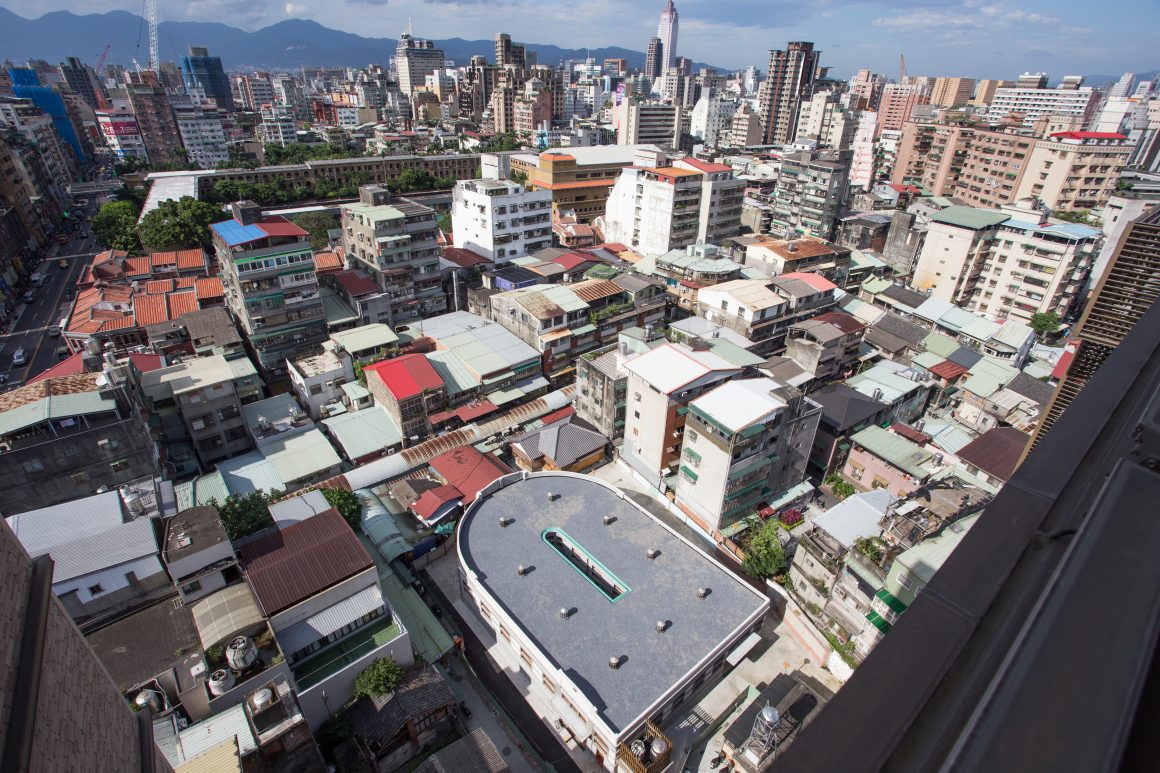 Xinfu Market, with Dongsanshui Street Market running perpendicular to the north. (Source: JUT Foundation for Arts and Architecture)
Xinfu Market, with Dongsanshui Street Market running perpendicular to the north. (Source: JUT Foundation for Arts and Architecture)
The sign for the market entrance on Kangding Road (康定路) indicates both Dongsanshui Street Market (東三水街市場) and Xinfu Market. Dongsanshui Street Market is what you will encounter first as you step into the covered walkway. Here you will find all manner of local goodies available for sale: every kind of tofu, vegetable, smoked, salted, or fresh meat, and a variety of clothing and accessories are for sale from the small stalls lining the long corridor.
Halfway down the length of Dongsanshui Street Market, on the right, you will find the entrance to Shintomicho Cultural Market (新富町文化市場), which is also the former site of the original Xinfu Market, and therein lies the surprise: it is nothing like Dongsanshui Street Market!
Xinfu Market was established in 1935 during the Japanese era. A horseshoe-shaped building with Art Deco flourishes, it primarily served the Japanese who settled in the area. The market was then reinvigorated in the 2000s as a museum showcasing the market culture of its time. Now rebranded as “U-mkt” after its unique U-shaped structure, Shintomicho Cultural Market is the heart of the region’s revitalization. The longstanding stalls from the original Xinfu Market continue their business on Dongsanshui Street, making the block a living “market trinity,” offering a glimpse into the old town’s historical roots.
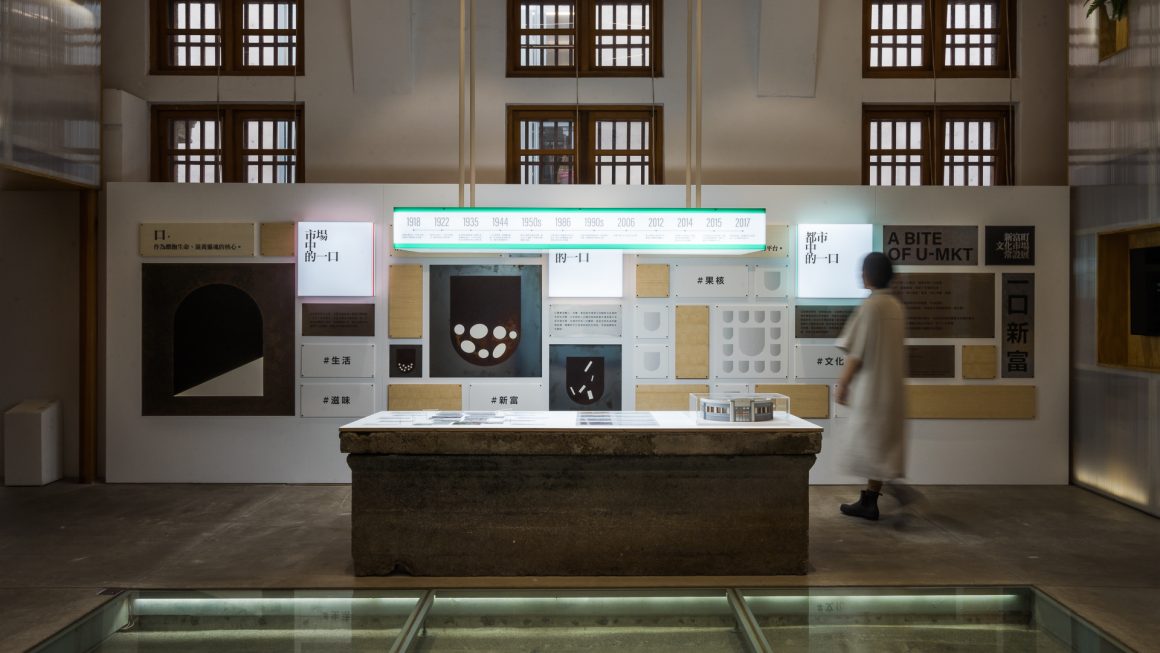 Avisitor takes in a exhibit on the history of Xinfu Market at U-mkt.(Source: JUT Foundation for Arts and Architecture)
Avisitor takes in a exhibit on the history of Xinfu Market at U-mkt.(Source: JUT Foundation for Arts and Architecture)
Getting up close and personal
A visit to Taipei’s indoor markets should be on the to-do list of any traveler keen to develop an understanding of Taiwan’s culture. These markets represent a living memory for Taiwanese people, a shared backdrop of daily reality that brings people together. Literally everyone and their parents and grandparents has been to these markets to pick up the ingredients of their signature dishes, where the sights and sounds of the vendors selling their products and customers picking out their purchases form some of the brightest threads in the tapestry of life in the city.
NANMEN MARKET 南門市場
- ADD 8, Sec. 1, Roosevelt Rd., Zhongzheng Dist.
- HOURS Tue. to Sun. 7:00am – 7:00pm
SHI-DONG MARKET 士東市場
- ADD 100, Shidong Rd., Shilin Dist.
- HOURS Tue. to Sun.
- 7:00am – 6:30pm (1F)
- 7:30am – 9:00pm (2F)
XINFU MARKET 新富市場
- ADD 70, Sanshui St., Wanhua Dist.
- HOURS Tue. to Sun.
- 08:00am – 3:00pm
- 10:00am – 6:00pm (U-mkt)
This article is reproduced under the permission of Taiwan Scene. Original content can be found on the website of Taiwan Scene.
Have you read?
- Zhuilu Old Road in Taroko National Park – Not for the Faint of Hear
- A day of sustainability: Exploring the eco-friendly wonders of Sun Moon Lake
- Soak in History: A Winter Journey to Taiwan's Timeless Hot Springs
Uploaded by Ian Huang






